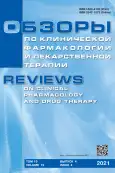Comparative characteristics of antimicrobial activity of water dispersions of silver and gold nanoparticles stabilized with native and synthetic polymers
- Authors: Shulgina T.A.1, Zubova K.V.2, Glinskaya E.V.2, Nechaeva O.V.3, Bespalova N.V.3
-
Affiliations:
- V.I. Razumovsky Saratov State Medical University
- Saratov State University
- Yuri Gagarin State Technical University
- Issue: Vol 19, No 4 (2021)
- Pages: 405-411
- Section: Original study articles
- Submitted: 01.02.2022
- Accepted: 01.02.2022
- Published: 15.12.2021
- URL: https://journals.eco-vector.com/RCF/article/view/100030
- DOI: https://doi.org/10.17816/RCF194405-411
- ID: 100030
Cite item
Abstract
BACKGROUND: The construction and application of antimicrobial drugs on the basis of nanoparticles of metals, silver and gold in particular, are staying casual up to now.
AIM: was to study the spectrum of antimicrobial activity of nanoparticles of silver and gold developed by means of chemical recovery and stabilized with native and synthetic compounds.
MATERIALS AND METHODS: The paper presents the results of a study of the antimicrobial activity of aqueous dispersions of silver and gold nanoparticles against standard and clinical strains of Staphylococcus aureus, which were sensitive to methicillin. Natural (carboxymethylcellulose, sodium oleate) and synthetic (polyvinyl alcohol, sodium dodecyl sulfate, polyazolidylammonium modified with iodine hydrate ions) polymeric compounds were used as stabilizers.
RESULTS: The high antistaphylococcal activity of the studied drugs was established, which depended on the stabilizer used. The highest efficiency of biocidal action was revealed for aqueous dispersions of metal nanoparticles stabilized with polyvinyl alcohol and polyazolidylammonium modified with iodine hydrate ions, which did not depend on the strain differences of microorganisms.
CONCLUSIONS: The results obtained open up prospects for the use of aqueous dispersions of silver and gold nanoparticles as active components in the development of new antiseptic preparations and photosensitizers for antimicrobial photodynamic therapy.
Full Text
About the authors
Tatiana A. Shulgina
V.I. Razumovsky Saratov State Medical University
Author for correspondence.
Email: tshylgina2012@yandex.ru
ORCID iD: 0000-0003-2393-6402
SPIN-code: 4148-3558
biologist
Russian Federation, 137, Bolshaya Sadovaya st., Saratov, 410000Kseniya V. Zubova
Saratov State University
Email: zubovaksushechka@mail.ru
ORCID iD: 0000-0002-9406-080X
SPIN-code: 2858-5323
Рostgraduate student
Russian Federation, 137, Bolshaya Sadovaya st., Saratov, 410000Elena V. Glinskaya
Saratov State University
Email: elenavg-2007@yandex.ru
ORCID iD: 0000-0002-1675-5438
SPIN-code: 2724-1359
Cand. Sci. (Biol.), Аssociate professor
Russian Federation, 137, Bolshaya Sadovaya st., Saratov, 410000Olga V. Nechaeva
Yuri Gagarin State Technical University
Email: olgav.nechaeva@mail.ru
ORCID iD: 0000-0003-3331-1051
SPIN-code: 9984-9594
Dr. Sci. (Biol.), Professor
Russian Federation, 137, Bolshaya Sadovaya st., Saratov, 410000Natalya V. Bespalova
Yuri Gagarin State Technical University
Email: n.v.bespalova.sstu@gmail.ru
ORCID iD: 0000-0003-3733-3119
SPIN-code: 1676-8226
Cand. Sci. (Phys. and Math.), Assistant professor
Russian Federation, 137, Bolshaya Sadovaya st., Saratov, 410000References
- Namazova-Baranova LS, Baranov AA. Antibiotic Resistance in Modern World. Pediatric Pharmacology. 2017;14(5):341–354. (In Russ.) doi: 10.15690/pf.v14i5.1782
- Zeng L, Zhan Z, Hu L, et al. Genetic Characterization of a blaVIM-24-Carrying IncP-7β Plasmid p1160-VIM and a blaVIM-4-Harboring Integrative and Conjugative Element Tn6413 From Clinical Pseudomonas aeruginosa. Front Microbiol. 2019;10:213. doi: 10.3389/fmicb.2019.00213
- Vsemirnaya Organizatsiya Zdravookhraneniya [Internet]. Global’naya strategiya VOZ po sderzhivaniyu ustoichivosti k antimikrobnym preparatam ot 2001 [update 2018 April 15]. Available from: https://www.who.int/drugresistance/WHO_Global_Strategy_ Russian.pdf
- Strachunskii LS, Kozlov SN. Sovremennaya antimikrobnaya khimioterapiya: rukovodstvo dlya vrachei. Moscow: Borges, 2002. 432 p. (In Russ.)
- Shcherbakov AB, Korchak GI, Surmasheva EV. Preparaty serebra: vchera, segodnya i zavtra. Farmatsevticheskii zhurnal. 2006;(5): 45–57. (In Russ.)
- Kim JS. Antimicrobial effects of silver nanoparticles. Nanomedecine: Nanotechnology, Biology and Medicine. 2007;3(1):95–101. doi: 10.1016/j.nano.2006.12.001
- Kuz’mina LN. Poluchenie nanochastits serebra metodom khimicheskogo vosstanovleniya. Zhurnal Rossiiskogo khimicheskogo obshchestva imeni DI Mendeleeva. 2007;(8):7–12. (In Russ.)
- Bukina YuA, Sergeeva EA. Antibakterial’nye svoistva i mekhanizm bakteritsidnogo deistviya nanochastits i ionov serebra. Vestnik Kazanskogo tekhnologicheskogo universiteta. 2012;15(14):170–172. (In Russ.)
- Park SJ, Jang YS. Preparation and characterization of activated carbon fibers supported with silver metal for antibacterial behavior. J Colloid Interface Sci. 2003;261(2):238–243. doi: 10.1016/S0021-9797(03)00083-3
- Litmanovich OE. Vzaimodeistvie makromolekul s nanochastitsami metallov i psevdomatrichnyi sintez zolei polimer – metallicheskikh nanokompozitov [dissertation abstract]. Moscow, 2006. 32 p.
- Nazarchuk OA, Faustova MO, Kolodii SA. Microbiological characteristics of infectious complications, actual aspects of their prevention and treatment in surgical patients. Novosti Khirurgii. 2019;27(3):318–327. (In Russ.) doi: 10.18484/2305-0047.2019.3.318
- Tiller JC, Liao C-J, Lewis K, Klibanov AM. Designing surfaces that kill bacteria on contact. Proceedings of the national academy of science. 2001;98(11):5981–5985. doi: 10.1073/pnas.111143098
- Kittler S, Greulich C, Diendorf J, et al. Toxicity of Silver Nanoparticles Increases during Storage Because of Slow Dissolution under Release of Silver Ions. Chem Mater. 2010;22(16):4548–4554. doi: 10.1021/cm100023p
- Shulgina T, Nechaeva O, Torgashova A., Darin N. Using the method of biotesting to assess the toxicity of waste medical and biological practices containing nanomaterials. IOP Conf. Series: Earth and Environmental Science. 2019;337:012012. doi: 10.1088/1755-1315/337/1/012012
- Verkhovskii R, Kozlova A, Atkin V, et al. Physical properties and cytotoxicity of silver nanoparticles under different polymeric stabilizers. Heliyon. 2019;5(3): e01305. doi: 10.1016/j.heliyon.2019.e01305
- Pomogailo AD, Rozenberg AS, Uflyand IE. Nanochastitsy metallov v polimerakh. Moscow: Khimiya, 2000. 672 p. (In Russ.)
- Federal’nyi tsentr gossanehpidnadzora Minzdrava Rossii. Opredelenie chuvstvitel’nosti mikroorganizmov k antibakterial’nym preparatam: metodicheskie ukazaniya. Moscow: Federal’nyi tsentr gossanehpidnadzora Minzdrava Rossii, 2004. 91 p. (In Russ.)
- D’yachenko SV, Kondrashkova IS, Zhernovoi AI. NMR studies of the sedimentation of ferromagnetic nanoparticles in a magnetic fluid. Technical Physics. 2017;87(10):1596–1598. (In Russ.) doi: 10.1134/S1063784217100097
- Shulgina TA, Verkhovsky RA, Nechaeva OV, Mylnikov AM. Evaluation of the cytotoxic effect of gold nanoparticles stabilized by polymer compounds on the mouse fibroblast cell culture L929. Problems in medical mycology. 2020;22(3):151. (In Russ.)








